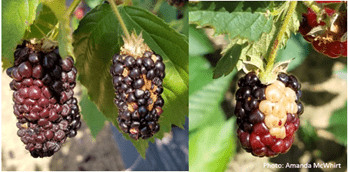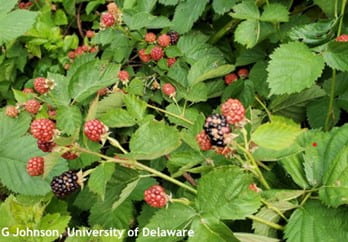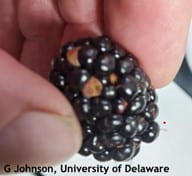Jul 12, 2021Watch for blackberry damage and disorders in the Northeast
Blackberries are being harvested throughout the Delaware region currently. The blackberry is a composite fruit with many tiny berries (druplets) attached to a receptacle. These druplets are subject to damage during the ripening period.
The following are some common problems with blackberries during fruiting:
Feeding results in only localized damage to one or two druplets most commonly. A secondary type of damage can occur if the stink bug injects its “stink” into the fruit while it is feeding. This may result in a blackberry fruit that can “taste like a stink bug smells”.
Stink bug damage
Stinkbugs feed on the fruit receptacle (the white part at the center of the fruit) and in doing so damage druplets as they insert their mouthparts. Stinkbugs may feed on green, red or black fruit.
Sunscald


Sunscald in blackberries
Sunburn of fruit is commonly seen when daytime temperatures exceed 90˚ F. At these temperatures fruit in direct sunlight may reach temperatures that exceed the air temperature by several degrees. When this occurs the fruit is essentially boiled by the sun. Symptoms include druplets that look “blanched” or “cooked.”
Most commonly, symptoms are present on only the side of the fruit exposed to the sun and the shaded side of the fruit will not have any damage.
Prevention methods include closely picking berries every few days, encouraging good plant health so that there is sufficient leaf cover to protect berries from the sun and orienting the trellis to shade the fruit for most of the day.
White druplet


White druplet disorder.
White druplet is associated with a drop in humidity and an increase in temperature. As this happens there is less moisture in the air to deflect solar radiation from directly contacting the berries. This increased solar radiation is blamed on individual or groups of druplets turning first white and then later brown in color.
This disorder is often a problem early on in the season and may lessen as the season progresses. Orienting the trellis to shade the fruit for most of the day is a method to prevent this disorder on susceptible varieties.
Information in this article is from What Is Going On With My Blackberry Fruit? by Amanda McWhirt – June 22, 2017, University of Arkansas https://www.uaex.edu/farm-ranch/crops-commercial-horticulture/horticulture/ar-fruit-veg-nut-update-blog/posts/fruitdisorders.aspx
– Gordon Johnson, Extension Vegetable & Fruit Specialist, University of Delaware
Photo at top: Stink bug damage in blackberry. Photos: Gordon Johnson















